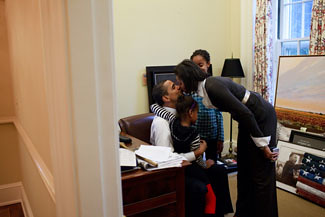
An article was published on Sunday, November 1, in The New York Times that talks about the Obama marriage. http://www.nytimes.com/2009/11/01/magazine/01Obama-t.html Days before and since, there has been much debate about whether they should be getting as much press about their marriage or whether their relationship is worth looking at as different than any other. I want to add my two cents to the conversation.
The article discussed many aspects of their marriage including a time that was their roughest, when they were having trouble. The highlights from this article, if used in the right context, could give us a glimpse into how a couple even with such high demands as the first couple can continue to love one another even through the tough times. The article may even be able to give the rest of us cues on how to make a marriage work and by understanding how to make a marriage work we can be inspired to make some changes in the devastatingly low statistics surrounding marriage in the Black community.
This summer, there was a study published, called the Marriage Index, which was developed by the National Center on African American Marriages and Parenting as well as the Institute for American Values. The Marriage Index proposes that there needs to be a national index to track marriages, just like we track everything else. In this index, marriage is highlighted in five areas, which are percentage of adults married (ages 20-54), percentage of married persons “very happy” with their marriages (ages 18 and up), percentage of first marriages intact (ages 20 – 59), percentage of births to married parents, percentage of children living with own married parents. These five areas highlighted in the index show some troubling information especially in the Black community. Here are some of the statistics:
- In 1970, 70.3% of African American adults (ages 20 – 54) were married but by 2008 the number of African Americans adults that were married (ages 20 – 54) had dropped dramatically to 39.6%.
- In 1970, the percentage of first marriages that were intact was 69.7%, but by 2008, the number of first marriages intact was 50.1%, which means that 50% of all marriages in the Black community ended in divorce.
- The last area that I will highlight is the percentage of births to married parents, in 1970 this was 62.4% but in 2008 the numbers had dropped drastically to 28.4%. This means that the majority of African American children are being born to unmarried parents, single parent households, or cohabiting couples. This is possibly one of the most alarming trends because the numbers are low enough for the first marriages but now our children are seeing that marriage doesn’t have to be an option and that the stability that a marriage can bring is no longer the norm in the black community.
“If my ups and downs, our ups and downs in our marriage can help young couples sort of realize that good marriages take work. . . .” Michelle Obama said a few minutes later in the interview. The image of a flawless relationship is “the last thing that we want to project,” she said. “It’s unfair to the institution of marriage, and it’s unfair for young people who are trying to build something, to project this perfection that doesn’t exist.”
Here are some insights that I gleaned from the interview that could help any marriage:
- A good marriage is worth fighting for.
- Everyone has differences.
- Acceptance of what your marriage looks like. If you don’t like what it looks like, you have to put in the work to change it.
- Marriage is a team approach, not a one man or one woman sport.
- Support of one another’s goals and dreams.
- The “I got your back mentality”.
- Communication is key.
- Do whatever it takes to make the marriage work, even doing away with the traditional roles mindset.
- Always wanting the best for one another.
- Supporting one another even through failures, not throwing it up in the other one’s face, no I told you so.
- Be protective of your wife and be protective of your husband.
- We need each other to truly succeed.
- Intimacy is key.
- Continue to date one another.
- The love the two of you share should be evident to those around you.
- Seek the support of others who support the success of your marriage.
- Marriage is a lifetime of renegotiations.
- Marriage can be good and can be happy.
These are just some of the key points that I took away from the article. Ultimately, the article shows a couple who has had some bumps in the road of their relationship, but is continuing to shape the future of their marriage in a very positive way not only for their children, but for ours. The Obamas are truly an inspiration to all of us of what a happy marriage can look like. Can you say the same about yours? Take some of these key points to create your own Obama state of mind, your own happy marriage and become a role model for marriage in your community.
No comments:
Post a Comment